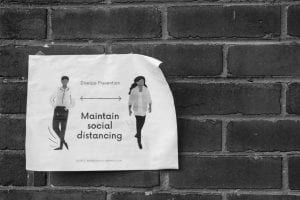 Writing about the 2008 Financial Crisis, photographer Matthew Frye Jacobson described "the omnipresent 'SPACE AVAILABLE' sign denoting a recently departed business [as] among the only public markers we have of the scale of our economic distress." He wrote of the "loneliness" of economic hardship in the modern era, with "no relief lines, no bread lines, no unemployment lines…no natural gathering places to note and process a communal experience."
Writing about the 2008 Financial Crisis, photographer Matthew Frye Jacobson described "the omnipresent 'SPACE AVAILABLE' sign denoting a recently departed business [as] among the only public markers we have of the scale of our economic distress." He wrote of the "loneliness" of economic hardship in the modern era, with "no relief lines, no bread lines, no unemployment lines…no natural gathering places to note and process a communal experience."
We are, of course, without gathering places now. But storefront to storefront, homemade 'shut' signs remind passersby that this is a communal experience, even as practices in self-isolation make COVID a lonely experience. These signs, often scrawled in Sharpie, urging us to maintain social distance and to maintain hope, make me wonder: Which of these will reopen? Which buildings will fall into disuse, joining the cavernous ranks of Bethlehem Steel's still-empty offices and warehouses? And is the loneliness of this moment any less because I can see by these signs that it’s shared?
 Businesses along Main Street display handmade Thank You’s in crayon hearts for healthcare workers and grocers, rubber gloves drawn by tracing hands like turkeys at Thanksgiving. On someone’s front door, there is a printed picture of a kitten dangling from a branch urging passersby to “hang in there,” a material meme. Other shop windows are plastered with clipart hearts that read “Stay Strong Bethlehem.”
Businesses along Main Street display handmade Thank You’s in crayon hearts for healthcare workers and grocers, rubber gloves drawn by tracing hands like turkeys at Thanksgiving. On someone’s front door, there is a printed picture of a kitten dangling from a branch urging passersby to “hang in there,” a material meme. Other shop windows are plastered with clipart hearts that read “Stay Strong Bethlehem.”
There are fearful signs, too, though. Four days after Michigan residents protested stay-at-home orders, a small business around the corner from my house raised a star-bordered  banner reading “America Is Stronger Than A Virus.”
banner reading “America Is Stronger Than A Virus.”
That night, I argued with someone I care for about what the sign means, about why “Stay Strong” is different than “Is Stronger Than,” the one urging patient endurance, the other challenging a pandemic to an arm-wrestling match. He said we owe our community members the benefit-of-the-doubt, that patriotism is not the exclusive domain of the radically far-right. I said that this kind of appeal to toughness and to patriotism is, that the sign is dangerous, that it minimizes the urgency of staying home. I cried that he and I read the same sign differently, and I don’t know why this was the first time I cried about COVID.
The next day, my neighbor raised an American flag on a hastily-made PVC pipe pole. I don’t know how to read that sign either.

























You must be logged in to post a comment.